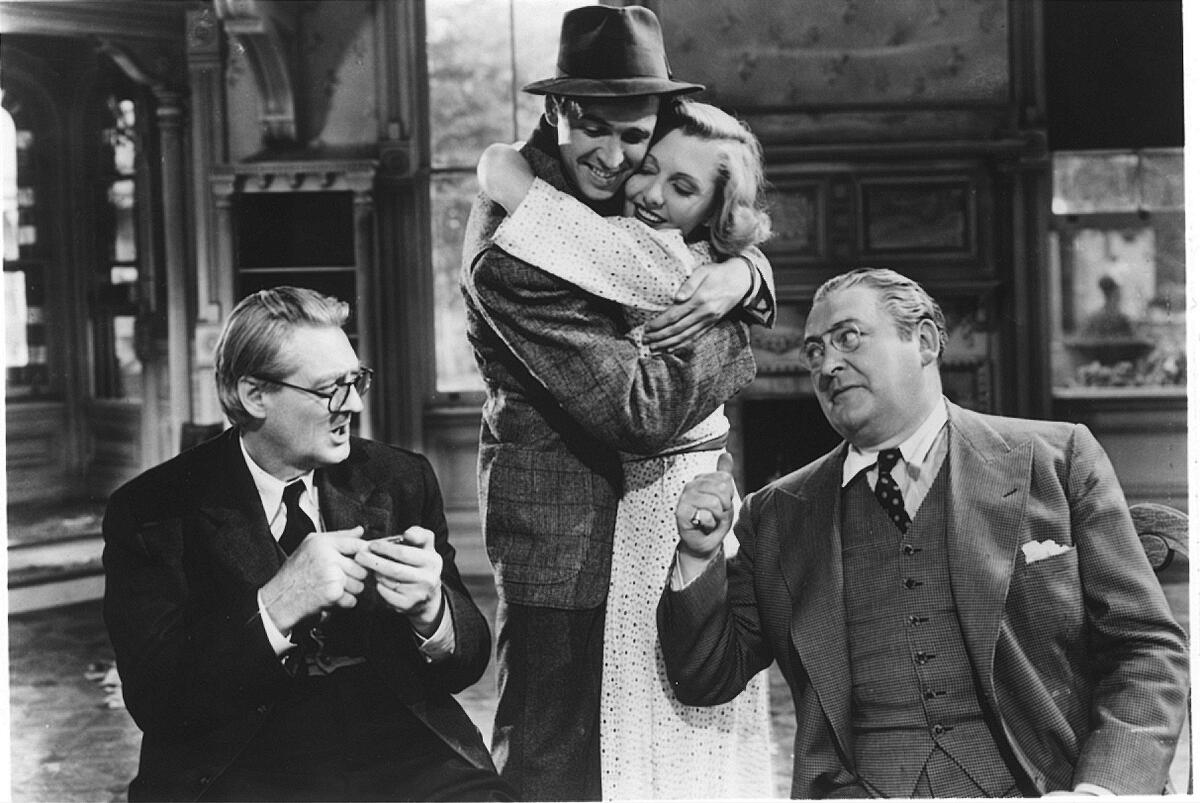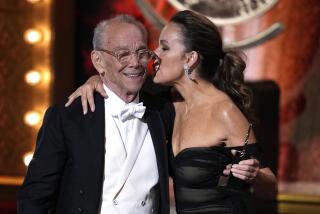From the Archives: ‘You Can’t Take It With You’ prize-winning film event

- Share via
Folks who really get a lot out of life are introduced in the film version of “You Can’t Take It With You,” directed by Frank Capra and exhibited at RKO Hillstreet and Pantages Hollywood theaters. It’s one of the most amusing and satisfying pictures to be seen in months, and certain to be an enormous hit with audiences. In fact, a run of several weeks might be predicted for this show, which is rich in human stuff, boasts a fine cast, and has all the other ingredients of true entertainment.
It’s very much in the Capra style that caused “It Happened One Night” and “Mr. Deeds Goes to Town” to be big screen successes. In some ways it’s more boisterous and engrossing even than its predecessors, and there’s a message of good will and good cheer besides that should find the highest favor with audiences.
Like neighbors
The family of the Sycamores might be your next door neighbors. At least, there are one or two that you may well recognize. People utterly without pretense, just trying to have a good time, and over them all as a sort of governor of kindness Martin Vanderhof, father and grandfather. Lionel Barrymore appears in that role, which is of the philosophical and hearty type that he has made familiar.
Jean Arthur is the granddaughter, Alice, who works for a living, and falls in Jove with James Stewart, the son of Wall Street’s great stock manipulator impersonated by Edward Arnold. Alice’s father (Samuel Hinds) and a Mr. DePinna (Halliwell Hobbes) spend their time manufacturing fireworks. Mrs. Sycamore (grandpa‘s daughter) writes novels and plays just because somebody left a typewriter at the house by mistake. Essie and Ed, married on naught whatsoever, financially, spend most of their time with music and dancing, and making candy to sell.
It’s a great throng, and Capra, using the substance of the George S. Kaufman and Moss Hart play, makes the most of them, thanks also to contributions by Robert Riskin, as scenarist. The finish they have developed for the picture is a marvel.
Fine teamwork
Arnold, of all the large group, probably gives the prize performance, because his hard-boiled banker characterization is demanding in its transitions, but everybody unites seemingly in what is a picture of splendid teamwork, with Stewart and Miss Arthur movingly sustaining the impression of young love, Barrymore compelling in his theories of life, Spring Byington, Mary Forbes, Mischa Auer, Donald Meek as other aces. A splendid scene is offered by H.B. Warner. Also Harry Davenport’s Judge is capital.
Ann Miller, Dub Taylor, Hinds, Hobbes, Eddie Anderson and Lillian Yarbo are other sharers in first honors. Charles Lane is of material assistance.
The feature occupies most of the program with a Disney Silly Symphony, “Wynken, Blynken and Nod,” imaginative and charming, as the other noteworthy program event. The serial “Dick Tracy Returns” is also viewed at some showings.
Capra’s prior picture to “You Can’t Take It With You” was “Lost Horizon,” and following that he had differences with Columbia Studio, where he works, which were finally adjusted. The team of Capra and Riskin has been broken up, at least temporarily, because Riskin has gone to Samuel Goldwyn studio to produce films. Jean Arthur was seen in “Mr. Deeds Goes to Town” under Capra direction, but quite a few of those appearing in “You Can’t Take It With You” are new in this maestro’s movies.
More to Read
Only good movies
Get the Indie Focus newsletter, Mark Olsen's weekly guide to the world of cinema.
You may occasionally receive promotional content from the Los Angeles Times.








